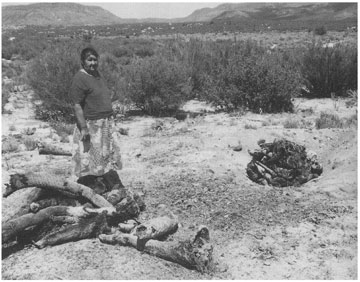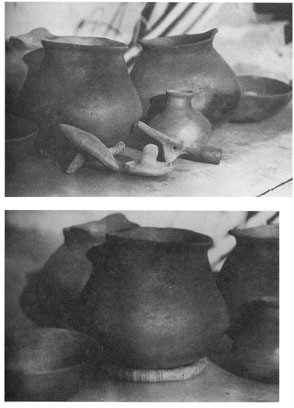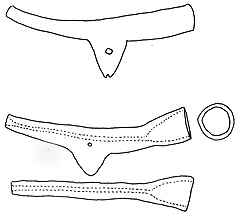

Teresa Castro and trunks of Mohave yucca near pit oven in which pottery has been stacked and covered with yucca trunks, Santa Catarina 1997. Not until she had grown into womanhood did she know of modern pots and pans and glass dishes. Her Kuatl (Southern Diegueño) mother made everything of clay. Castro's Paipai father had taken his family to a remote valley 40 miles from Santa Catarina toward the Pacific Ocean near San Vicente, a valley rich in acorns and other gathering opportunities. Isolated in the valley called Dolores, they lived with only one other Paipai family for her childhood and youth. She recalled the day they discovered a cave full of wooden weapons and tools made by Indians long before. Her father said it was best to leave such things untouched and they did.
Where was Dolores Valley? I did not find it on the old maps or Baja guides, but I remembered an account of exploration in Lower California by Arthur North. In early 1906, he had taken a wrong direction as he headed south from Alamo into uncharted territory. A day of hacking through dense brush high in the Sierras, avoiding chollas and Spanish bayonets, brought him to an ancient trail worn deep into the granite of the mountain -- at one point he measured its depth with a tape at 38" into the rock! Farther on the trail his parry noted fresh mountain lion tracks mingled with those of barefooted Indians. The path descended into an arroyo and on a small sandy bench above the stream came abruptly upon an Indian village of some six huts. Men clad with knife belts, sandals and happy smiles met his party and gave him to know in broken Spanish they were Pai; naked children played, boys practicing with stout bows and reed arrows and girls carrying babies at their sides; on metate stones women crushed corn and a small black seed (like that "found in the crops of wild doves"). North described them as "a healthy, husky looking race of people." The Indians declared North and his party the first whites ever to come to the village known as Dolores.
North was not far from an agua caliente, or warm spring,
he reached further down the valley by nightfall, a perfect camping
spot. This in turn was near the Mission of San Vicente. Both are
found on modern maps. The village of Dolores and Teresa's valley
of Dolores must have been one in the same and located upstream
from Agua Caliente on Rio San Vicente.

Above, cooking bowls of Paipai Josefina Ochurte, some with tab-like rim handles,flanked by food bowls and small canteen. Pipe and anvils to the .front. Below, the cooking bowl resting on a Kumeyaay ring made of a hoop of split juncus strips wound with more split juncus. Mohave women used similar rings to carry large bowls on their heads.
That is no ordinary pipe, Benito Peralta was quick to point out as I purchased a small clay pipe made by his sister Josefina Ochurte. It has its mystery, its story, he told me; such pipes were smoked only once a year by one special man during a mourning ceremony which involved an eagle. Peralta, an elder of the Paipai, learned of its function in his youth from old people of his tribe who had learned the story in turn from those long before them. The pipe and the eagle were part of the same story.
Before the ceremony, which mourned those who had died the previous year, a specially designated man went out and captured an eaglet. He climbed a high cliff to the aerie, took the bird and descended. They held the eagle in a cage and raised him until he became a fully fledged adult. They treated the eagle well and respected him.
As the sun rose on that day of the mourning ceremony, the eagle was placed under a great ramada shade built especially fir the occasion. He could be seen under the ramada weeping for the departed in the early morning light. He had known what was to befall him even before the dawn. It was then the man with the pipe approached the eagle and lit the tobacco -- the coyote tobacco which grows around here -- in the pipe. He drew the smoke into his mouth and blew it directly into the face of the eagle, usually only three or four times before the bird collapsed and died.
(It is interesting to note that Pedro Fages' eighteenth-century account of the Chumash, who are also of the Hokan linguistic stock, included mention of smoke from a pipe in a mortuary ceremony: At daybreak, the priest, smoking a large stone pipe, passed three times around the person's body and each time he stopped and blew three mouthfuls of smoke upon the departed's head.)
When we die, Peralta reflected, the eagle's spirit carries our soul to wherever it is we go. So, during the mourning ceremony, little bundles were made of the eagles'.feathers and each bundle tied securely. Wherever anyone had passed away the previous year, there a bundle was laid. Then as a singer chanted the songs of the Paipai and the people danced in a long line, the eagle and bundles of feathers were brought together and burned, consumed in fire just as the deceased had been the year before.
The eagle is very special to us, said Peralta, we would never kill him for sport or for food though he might land right next to us. Neither do we smoke these clay pipes for mere pleasure.

Above, old Southern Diegueño pipe (drawn from Rogers, 1936). Below, three views of a Paipai pipe (nearly 5-3/4" long), Santa Catarina, 1994.
The article is from the book, entitled "Survival Skills of Native California" (ISBN 0-87905-921-4), by Paul Douglas Campbell. Permission to use the article on the PrimitiveWays website was given by Mr. Campbell. Paul Campbell can be contacted through his publisher, Gibbs Smith, P.O. Box 667, Layton, Utah 84041.
We hope the information on the PrimitiveWays website is both instructional and enjoyable. Understand that no warranty or guarantee is included. We expect adults to act responsibly and children to be supervised by a responsible adult. If you use the information on this site to create your own projects or if you try techniques described on PrimitiveWays, behave in accordance with applicable laws, and think about the sustainability of natural resources. Using tools or techniques described on PrimitiveWays can be dangerous with exposure to heavy, sharp or pointed objects, fire, stone tools and hazards present in outdoor settings. Without proper care and caution, or if done incorrectly, there is a risk of property damage, personal injury or even death. So, be advised: Anyone using any information provided on the PrimitiveWays website assumes responsibility for using proper care and caution to protect property, the life, health and safety of himself or herself and all others. He or she expressly assumes all risk of harm or damage to all persons or property proximately caused by the use of this information.
© PrimitiveWays 2013